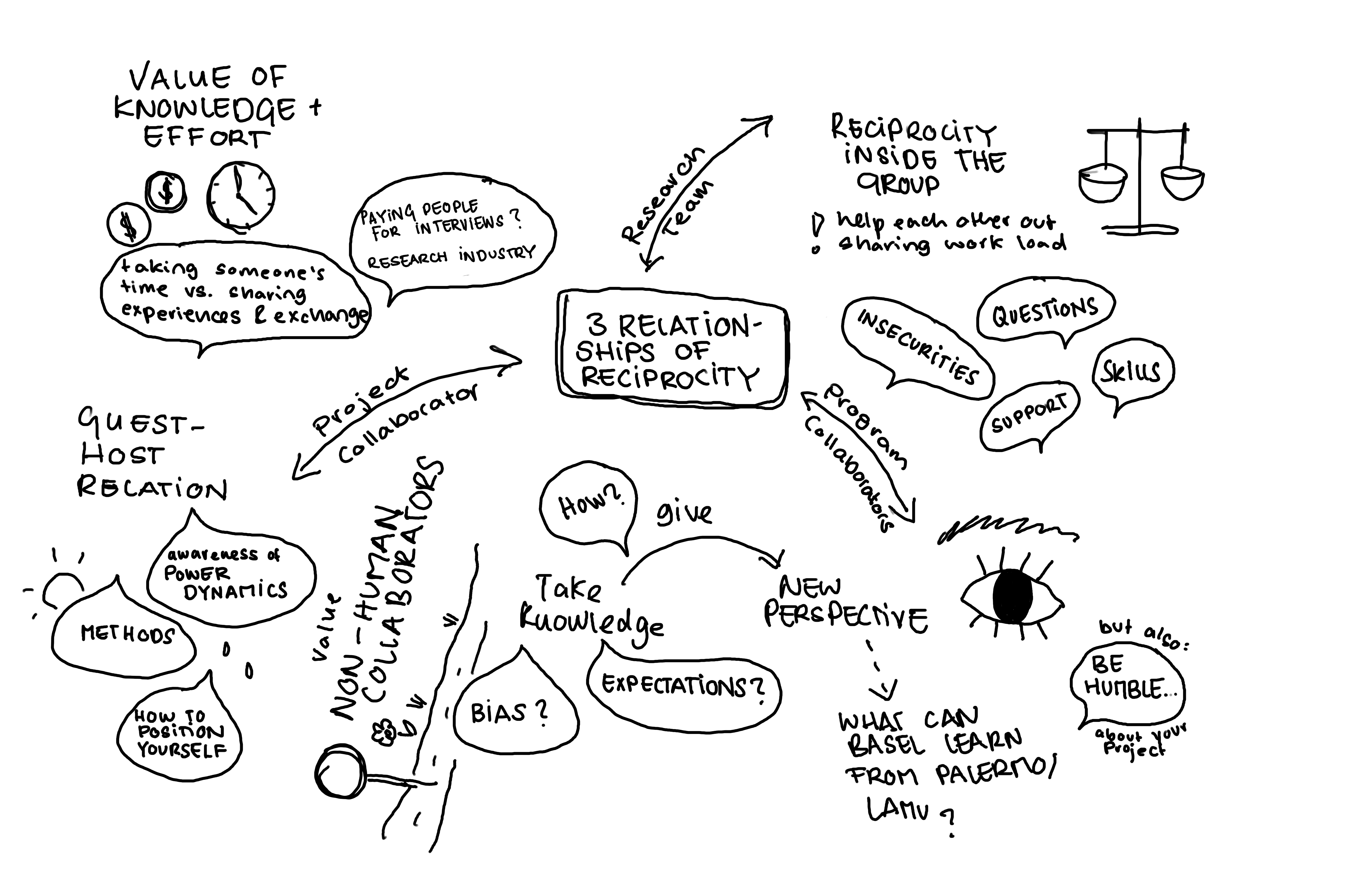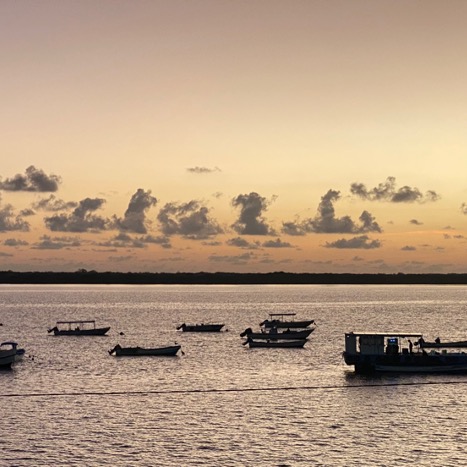Lamufutures
Process
How could a meaningful collaboration be developed between a local youth organisation and a university program based in Switzerland?
How could research-led pedagogy contribute to local empowerment and transformation?
Our project addresses the ways in which communities of the ancient Indian Ocean port city of Lamu are managing environmental and social change due to the implementation of the Lamu Port-South Sudan-Ethiopia-Transport (LAPSSET) Corridor. A six-week collaboration between Critical Urbanisms students and volunteer researchers from the Lamu Youth Alliance in 2023 delved into the architectural, urban, and social dimensions of change, relating histories of (post)colonial trauma to debates about the future development of Lamu.
By combining the urban humanities with engaged research in partnership, we aim to build pathways for communities to negotiate their stake in projects directed from elsewhere.
We conducted collaborative and action research with the Lamu Youth Alliance, encompassing urban and environmental mapping, audiovisual production, and documentary filmmaking.
We conducted collaborative and action research with the Lamu Youth Alliance, encompassing urban and environmental mapping, audiovisual production, and documentary filmmaking.
Ocean as Method
Collaboration
Reciprocity

Striving for ways of working and outcomes that benefit all parties involved, emphasizing mutual exchange and understanding.
Positionality

Understanding how our individual and structural positions and movements shape research processes and final outcomes.
Collaboration
A fundamental goal of our project was to develop non-extractive modes of research. Collaborating closely with the community-based organisation Lamu Youth Alliance was central to this commitment to produce transformative work.
Collaborating in mixed teams helped countering colonial roles and inherited hierarchies, such as that between researchers and researched.
"In our initial week in Lamu we built rapport with the Lamu Youth Alliance members through city walks, group discussions, meditation sessions, and shared dinners. These interactions allowed us to understand our research partners better and also helped us identify our collective skill sets and learning objectives for the upcoming weeks."

In Lamu, NGOs operate across various sectors, including youth empowerment, cultural heritage preservation, environmental conservation, healthcare, and more. The proliferation of NGOs in Lamu shape on-site power dynamics and guest-host relationships from the outset.
The prevalence of numerous NGOs significantly influences how the local population perceives researchers. Given the consistent presence of researchers and their anticipated inquiries, many interviewees have rehearsed responses, having shared their stories repeatedly.
Consequently, one of the primary challenges encountered during the research was access to more personal perspectives and experiences. Kenya's intensive development research industry made it challenging to steer conversations towards more personal narratives. Additionally, navigating the expectations and interests of multiple stakeholders, including the students, the Lamu Youth Alliance, and the wider community, was not without its challenges.
"Reaching a consensus on research topics and outcomes that harmonised with all parties proved challenging initially. LYA understandably sought research outcomes that could directly benefit the community, prioritising practical results like policy recommendations and reports on matters already significant to the organisation. Even though this initially appeared daunting, considering our brief six-week stay and limited research experience as students, it ultimately proved successful, with both parties content with the selected topics."
"Reaching a consensus on research topics and outcomes that harmonised with all parties proved challenging initially. LYA understandably sought research outcomes that could directly benefit the community, prioritising practical results like policy recommendations and reports on matters already significant to the organisation. Even though this initially appeared daunting, considering our brief six-week stay and limited research experience as students, it ultimately proved successful, with both parties content with the selected topics."
“Each Lamu Youth Alliance member had different skills, which were matched to complement the skills of the University of Basel students. Each gave their best. That's how it worked. The roles and distribution of tasks were fair since everyone was tasked with what was best to them.”
- Lamu Youth Alliance Member
- Lamu Youth Alliance Member
Ocean as
Method
In Lamu as elsewhere, the ocean is not a natural boundary, or even an extension of the land. It is a crucial part of people’s livelihoods and belonging. Littoral societies are dependent on maritime ecologies and in constant exchange across the sea.
The cultural theorist Iain Chambers approaches the sea as a metaphor epitomizing the inherent instability and fluidity of knowledge production.
Examining the Lamu archipelago through a maritime lens means seeing the Indian Ocean not merely as a transit route for goods but also as the medium of everyday life and the connection between histories and futures.
Consequently, our work centers on the journeys, navigations, and livelihoods on the ocean, providing insights into the dynamics of the Lamu Archipelago and the Indian Ocean's paramount significance.
The cultural theorist Iain Chambers approaches the sea as a metaphor epitomizing the inherent instability and fluidity of knowledge production.
Examining the Lamu archipelago through a maritime lens means seeing the Indian Ocean not merely as a transit route for goods but also as the medium of everyday life and the connection between histories and futures.
Consequently, our work centers on the journeys, navigations, and livelihoods on the ocean, providing insights into the dynamics of the Lamu Archipelago and the Indian Ocean's paramount significance.
Using the ocean as a method presents its own challenges. As many residents in Lamu do not rely on conventional maps for navigation, mapping efforts relied on direct observations during boat trips.
“Some boat captains mentioned using stars for night-time navigation at sea. When inquiring about fishing locations, fishermen would gesture towards the water rather than pinpointing spots on a map.”
As a result, our research primarily relied on observations during boat trips, enabling us to map waterways and identify fishing and mangrove-cutting locations. Locals provided us with names of familiar places, common fishing spots, and descriptions of their routes, which we integrated with our tracking data to create accurate waterway maps.
“Some boat captains mentioned using stars for night-time navigation at sea. When inquiring about fishing locations, fishermen would gesture towards the water rather than pinpointing spots on a map.”
As a result, our research primarily relied on observations during boat trips, enabling us to map waterways and identify fishing and mangrove-cutting locations. Locals provided us with names of familiar places, common fishing spots, and descriptions of their routes, which we integrated with our tracking data to create accurate waterway maps.
Reciprocity
Our project aimed to create a positive impact on both the student researchers and the local community. Striving for reciprocity presented challenges in the selection of relevant research topics that would resonate with all the parties involved.
Yet our differences about research priorities is what made intensive exchange and therefore truly co-created knowledge possible.
The commitment to reciprocity also extended to ensuring the public nature of our work. Apart from research workshops, we organized a public exhibition and party at the Lamu Fort Museum during the final week of our research. We supported all our research participants to be able to participate in the event. Rather than academic presentations, we showed our films, exhibited drawings and maps, and invited local actors and musicians from the IDP community to perform. The event was open to the public and one of the films was projected on Lamu’s main square in front of the fort.
Yet our differences about research priorities is what made intensive exchange and therefore truly co-created knowledge possible.
The commitment to reciprocity also extended to ensuring the public nature of our work. Apart from research workshops, we organized a public exhibition and party at the Lamu Fort Museum during the final week of our research. We supported all our research participants to be able to participate in the event. Rather than academic presentations, we showed our films, exhibited drawings and maps, and invited local actors and musicians from the IDP community to perform. The event was open to the public and one of the films was projected on Lamu’s main square in front of the fort.
“The true significance of the final public event became evident through the reactions of our research participants. For instance, one individual approached us after the film screening, emotionally expressing gratitude for including them in the film and highlighting specific sequences they wanted to share. After viewing it, another woman, who initially sought financial support for housing, requested copies of the film to share with her family and community in other parts of Lamu County.”

Mind map of three relationships of reciprocity (Amélie Rywalski, Fiona Hager and Tanja Meier)
 Public presentation of the film “Nyumbani ni Nyumbani” on Mkunguni Square in Lamu, 4 May 2023
Public presentation of the film “Nyumbani ni Nyumbani” on Mkunguni Square in Lamu, 4 May 2023“The public presentation was fantastic
and made the community proud of us.
The locals, maybe for the first time after being asked to participate in research so many times, were presented with the research findings. We hope this will help future researchers as the community now will be more willing to be interviewed and share what they have, since they know it will be given back to them at last”
- Lamu Youth Alliance Member
“The public presentation was fantastic
and made the community proud of us.
The locals, maybe for the first time after being asked to participate in research so many times, were presented with the research findings. We hope this will help future researchers as the community now will be more willing to be interviewed and share what they have, since they know it will be given back to them at last”
and made the community proud of us.
The locals, maybe for the first time after being asked to participate in research so many times, were presented with the research findings. We hope this will help future researchers as the community now will be more willing to be interviewed and share what they have, since they know it will be given back to them at last”
- Lamu Youth Alliance Member
Positionality
Striking a balance between acknowledging power dynamics and not reducing participants’ agency in decision-making was crucial to avoid the unintended reproduction of racialised hierarchies.
“During our research in Lamu, we experienced time and again how the white people in our group were attributed to specific attributes like access to political power or financial resources. These attributions significantly impacted the researchers' expectations and interactions with participants.”
One of our concrete challenges was allowing interlocutors to share their stories without fostering false hopes and unmet expectations of economic or political benefit. We emphasised transparency in communicating about the scope and limitations of our work to participants, yet a level of uncertainty persisted, particularly among those expressing a strong desire for change.
"In the case of a participant who reluctantly agreed to be filmed for the project, I felt unsettled contemplating the potential role of underlying power dynamics. However, acting upon my presumption that her agreement was solely due to such dynamics could also diminish her ability to make her own choices. This situation called attention to my own positionality, where I may have wrongly assumed that, as a white student, I automatically held more power, leading to automatic agreement with my requests."
Another important aspects of the researchers’ positionality was gender. We noticed markedly different reactions from interlocutors depending on the gender of the researcher. These dynamics can sometimes to be navigated strategically, demonstrating the critical role of positionality in shaping research dynamics and outcomes.
"Being the only woman on our team initially required me to establish credibility. I observed that people approached other team members differently than they did me. In certain instances, I took a step back as I went unnoticed by men. However, I also discovered advantages, as some individuals felt more comfortable opening up to me than my male team members. Consequently, our team could strategically decide who would lead discussions or handle introductions based on the people we were engaging with."
Evening group meeting on the floating restaurant with invited guests
Thank you to the Critical Urbanisms students from the Palermo track, for the thinking together about these issues across geographies.

